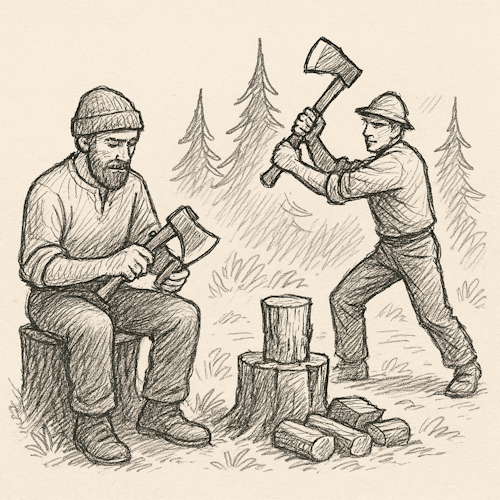Two Woodcutters
Illustrates Technical Excellence, Sustainable Pace, Improvement
Agile teams often feel pressure to deliver continuously, Sprint after Sprint. In that environment, it's easy to mistake busyness for effectiveness. The Two Woodcutters parable illustrates the value of deliberate improvement, reflection, and sustainable pace. Teams and organizations that never stop to sharpen their saw, whether through Retrospectives, learning, or improving tools and processes, often fall behind despite working harder.

Two woodcutters, Alex and Ben, were challenged to a competition: Who could cut down more trees in a single day?
At sunrise, both entered the forest. Alex attacked the trees relentlessly, barely stopping for food or water. Ben, on the other hand, paused for ten minutes every hour.
Alex laughed. "Ben is so lazy. I'll win easily."
But at the end of the day, the judges counted the trees. To Alex's shock, Ben had cut down significantly more.
"How did you beat me?" Alex demanded. "You stopped all the time!"
Ben replied, "I wasn't resting. I was sharpening my axe."
Lessons Learned
Sustainable Pace Beats Exhaustion
Agile is not about burning out Sprint after Sprint. Recovery and retrospection are vital.
Time Invested in Improvement Pays Off
Pausing to improve tools, practices, or communication increases throughput long-term.
Productivity ≠ Busyness
Just being active is not enough. Effectiveness depends on how wisely we work.
Learning is Work
Training, reflection, and feedback loops should be seen as valuable contributions, not distractions.
Coaching Tips
- Protect Retrospectives: Ensure they are not skipped or rushed. This is where teams sharpen their axe.
- Challenge Hero Culture: If a team idolizes overwork, introduce this parable to shift the mindset.
- Track Technical Debt and Friction: Ask teams, “What slows you down?” and prioritize improvements.
- Promote Learning Time: Encourage spikes, lunch-and-learns, and book clubs as part of regular flow.
- Measure Outcomes, Not Hours: Highlight where outcomes improved after investing in learning or tooling.
The Two Woodcutters teaches a timeless lesson: sustainable, deliberate improvement leads to better outcomes than mindless hustle. Agile teams thrive not when they work nonstop, but when they work wisely. As a coach, this parable is a powerful tool to help teams slow down, reflect, and build capacity for the long haul.


